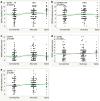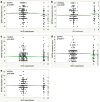Differences in the expression of SSTR1-5 in meningiomas and its therapeutic potential
- PMID: 33899156
- PMCID: PMC8827401
- DOI: 10.1007/s10143-021-01552-y
Differences in the expression of SSTR1-5 in meningiomas and its therapeutic potential
Abstract
Beyond microsurgical resection and radiation therapy, there are currently no established treatment alternatives for meningioma patients. In selected cases, peptide radio receptor therapy (PRRT) can be implemented. For this purpose, a radionuclide is bound to a substance targeting specific receptors in meningiomas. One of them is somatostatin receptor 2, which can be found in most meningiomas. However, other somatostatin receptors (SSTR) exist, but their expressions have only been described in small case series. In this study, we analyzed the expression of SSTR1, 2A, 3, 4, and 5 in a large cohort of meningiomas in order to enable further refinement of this innovative treatment option. Overall, 726 tumor samples were processed into tissue microarrays and stained for SSTR1, 2A, 3, 4, and 5 immunohistochemically. Microscopic evaluation was done with an established semiquantitative score regarding percentual quantification and staining intensity, and results were correlated with clinical data. There was a significant lower rate of SSTR1 expression in meningiomas of male patients. Older age was associated with higher expression of SSTR1, 2A, and 5 and lower scores for SSTR3 and 4. Tumors treated with radiotherapy before resection showed lower rates of SSTR1 and 5 expression, while recurrent meningiomas had lower SSTR1 scores. Tumor tissue from patients suffering from neurofibromatosis type 2 had lower expression scores for SSTR1, 2, and 5. For SSTR3 and 4, NF2 patients showed higher scores than sporadic tumors. Spinal meningiomas had higher scores for SSTR1, 4, and 5 compared tumor location of the skull base and convexity/falx. Overall, higher WHO grade was associated with lower SSTR scores. While all SSTRs were expressed, there are marked differences of SSTR expression between meningioma subgroups. This has the potential to drive the development of more selective PRRT substances with higher treatment efficacy.
Keywords: Immunohistochemistry; Meningioma; Neurofibromatosis; Peptide receptor radionuclide therapy (PRRT); Somatostatin receptor; Tissue microarray.
© 2021. The Author(s).
Conflict of interest statement
The authors declare no competing interests.
Figures





Similar articles
-
Expression of somatostatin receptors in canine and feline meningioma.Vet Med Sci. 2024 Jul;10(4):e1537. doi: 10.1002/vms3.1537. Vet Med Sci. 2024. PMID: 39011594 Free PMC article.
-
The Current Role of Peptide Receptor Radionuclide Therapy in Meningiomas.J Clin Med. 2022 Apr 23;11(9):2364. doi: 10.3390/jcm11092364. J Clin Med. 2022. PMID: 35566491 Free PMC article. Review.
-
The immunohistochemical expression of SSTR2A is an independent prognostic factor in meningioma.Neurosurg Rev. 2022 Aug;45(4):2671-2679. doi: 10.1007/s10143-021-01651-w. Epub 2021 Oct 2. Neurosurg Rev. 2022. PMID: 34601710 Free PMC article.
-
Expression of somatostatin receptors (SSTR1-SSTR5) in meningiomas and its clinicopathological significance.Int J Clin Exp Pathol. 2015 Oct 1;8(10):13185-92. eCollection 2015. Int J Clin Exp Pathol. 2015. PMID: 26722517 Free PMC article.
-
Role of adjuvant radiotherapy in atypical (WHO grade II) and anaplastic (WHO grade III) meningiomas: a systematic review.Clin Transl Oncol. 2021 Feb;23(2):205-221. doi: 10.1007/s12094-020-02434-3. Epub 2020 Jul 10. Clin Transl Oncol. 2021. PMID: 32651886
Cited by
-
Somatostatin receptor subtype expression and radiomics from DWI-MRI represent SUV of [68Ga]Ga-DOTATOC PET in patients with meningioma.J Neurooncol. 2023 Sep;164(3):711-720. doi: 10.1007/s11060-023-04414-3. Epub 2023 Sep 14. J Neurooncol. 2023. PMID: 37707754 Free PMC article.
-
Expression of somatostatin receptors in canine and feline meningioma.Vet Med Sci. 2024 Jul;10(4):e1537. doi: 10.1002/vms3.1537. Vet Med Sci. 2024. PMID: 39011594 Free PMC article.
-
Radioligand therapies in meningioma: Evidence and future directions.Neuro Oncol. 2024 Dec 9;26(Supplement_9):S215-S228. doi: 10.1093/neuonc/noae069. Neuro Oncol. 2024. PMID: 38702966 Free PMC article. Review.
-
The Current Role of Peptide Receptor Radionuclide Therapy in Meningiomas.J Clin Med. 2022 Apr 23;11(9):2364. doi: 10.3390/jcm11092364. J Clin Med. 2022. PMID: 35566491 Free PMC article. Review.
-
Expression of SSTR2a, FAP, HER2 and HER3 as potential radionuclide therapy targets in higher-grade meningioma.Eur J Nucl Med Mol Imaging. 2025 Jul;52(8):2771-2781. doi: 10.1007/s00259-025-07075-8. Epub 2025 Jan 16. Eur J Nucl Med Mol Imaging. 2025. PMID: 39969538 Free PMC article.
References
-
- Arena S, Barbieri F, Thellung S, Pirani P, Corsaro A, Villa V, Dadati P, Dorcaratto A, Lapertosa G, Ravetti JL, Spaziante R, Schettini G, Florio T. Expression of somatostatin receptor mRNA in human meningiomas and their implication in in vitro antiproliferative activity. J Neurooncol. 2004;66:155–166. doi: 10.1023/b:neon.0000013498.19981.55. - DOI - PubMed
-
- Barresi V, Alafaci C, Salpietro F, Tuccari G. Sstr2A immunohistochemical expression in human meningiomas: is there a correlation with the histological grade, proliferation or microvessel density? Oncol Rep. 2008;20:485–492. - PubMed
-
- Brastianos PK, Galanis E, Butowski N, Chan JW, Dunn IF, Goldbrunner R, Herold-Mende C, Ippen FM, Mawrin C, McDermott MW, Sloan A, Snyder J, Tabatabai G, Tatagiba M, Tonn JC, Wen PY, Aldape K, Nassiri F, Zadeh G, Jenkinson MD, Raleigh DR, International Consortium on M Advances in multidisciplinary therapy for meningiomas. Neuro Oncol. 2019;21:i18–i31. doi: 10.1093/neuonc/noy136. - DOI - PMC - PubMed
MeSH terms
Substances
LinkOut - more resources
Full Text Sources
Research Materials
Miscellaneous

